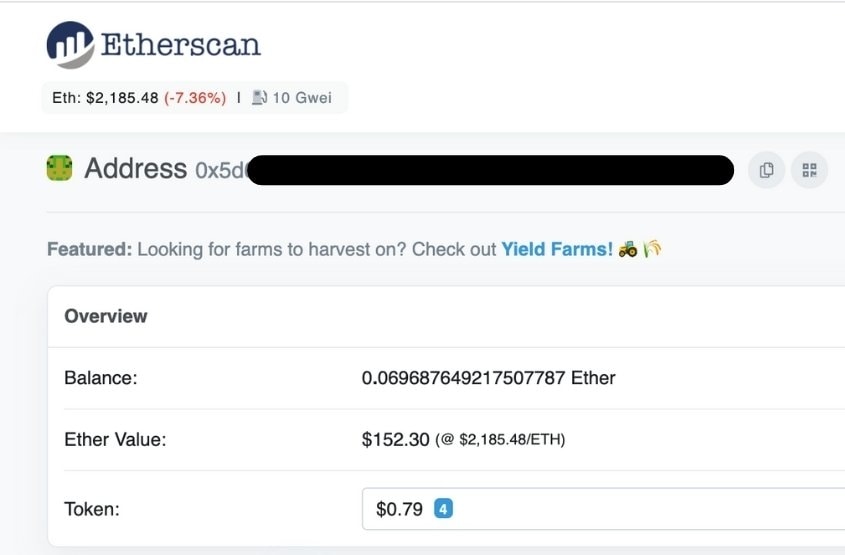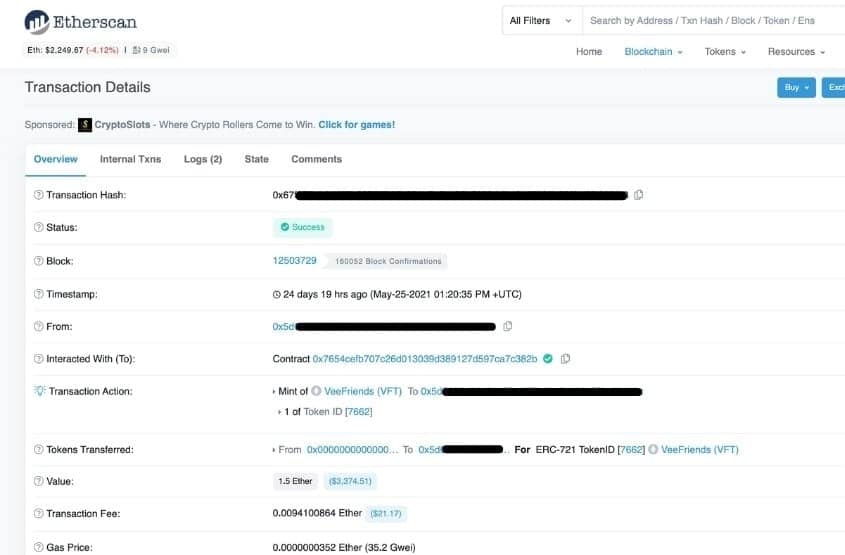Knowing how to verify NFT ownership is an important piece of the puzzle when trying to understand blockchain technology—it’s far different than the internet.
Having collected over 100 NFTs myself, I’ve learned the exact method to verify NFT ownership. Now I want to share this quick and easy method with you.
How to Verify NFT Ownership

1. Go to Etherscan.io and enter a wallet address
To start, go to Etherscan and enter a public wallet address, transaction hash, block, or token. For this example, I used my own public wallet address.
Note that you can just as easily enter someone else’s wallet address and find the same information.
But wait, what is Etherscan?
Etherscan is the Ethereum Blockchain Explorer. Etherscan allows you to search for a specific wallet address, transaction, block, or token by using a public wallet address or Ethereum Name Service (ENS) on the blockchain.
Every NFT exists on the blockchain. Hence, you can use Etherscan to verify NFT ownership.

2. Select the desired NFT you want to verify

In order to check a specific NFT’s transaction data, choose the dropdown arrow and select the token transactions you would like to view.
This will take you to a historical list of transactions for the specific token type you chose to view in your wallet.
3. Select a transaction (Txn) hash to view

Depending on how many tokens you have available in your wallet, there may be multiple transactions to choose from.
Pick whichever transaction you would like to view and verify. Simply click on the Txn Hash to view the exact details of a specific transaction.
4. Look at the NFT’s ‘Status’ and ‘Tokens Transferred’ to verify ownership

After you have selected the NFT transaction you want to verify, you will be brought to this page which displays all the details of the NFT transaction.
These details include but are not limited to:
- Transaction Hash (A unique 66-character identifier given to each token)
- Status (Success or failed)
- Block (Block confirmation)
- Timestamp (Date and time)
- From (Sending address)
- Interacted With (To/receiving address)
- Transaction Action (Mint quantity and receiver)
- Tokens Transferred (From and to)
- Value (Current value and at the time of purchase if you click)
- Transaction Fee (Gas fee)
- Gas Price (Cost per unit of gas spent on the transaction)
- Ether Price (On the date of transaction)
- Gas Limit (Maximum amount of gas provided for the transaction)
- Gas Used by Transaction (The exact amount of gas used for the transaction)
- Nonce (Sequential running number for an address, beginning with 0 for the first transaction)
- Input Data (Additional info required for the transaction)
By viewing the section that says “Tokens Transferred From and To, you can verify who owns the NFT currently.
The address listed after “To” is the current owner of the NFT in question.
Can You Fake NFT Ownership?
You can’t fake owning an NFT. All of an NFT’s transaction data is stored on the blockchain indefinitely for anyone to view. Hence, if someone claims to own an NFT you can easily check the blockchain to verify who truly owns it.
That’s not to say that you can’t screenshot an NFT—because you can. But, it’s completely pointless as you wouldn’t gain anything from it.
That would be like me taking a picture of your car and saying I own it. Just because I have a picture of it doesn’t mean I own the keys to it or can hop in and drive it away. The same goes for NFT ownership.
There are various utilities that can be added to an NFT that can only be accessed if you are the true owner of the token. So, there really is no way to fake owning an NFT.
What Is the Safest Way to Verify the Authenticity of an NFT?
The safest way to verify the authenticity of an NFT is by using the blockchain. A tool like Etherscan can be used to identify the original creator, mint date, and total supply. Also, certain NFT marketplaces have their own verification marks—but the blockchain remains 100% accurate.
That said, the steps listed above are a perfect way to verify an authentic NFT.
Tracking and verifying any NFT before making a purchase should be common practice. You should never spend money on something you don’t know to be 100% authentic.
That’s why verifying NFTs is so important.
Tracking and verifying an NFT transaction also enables you to verify the transaction has been completed successfully and sent to the correct address for the agreed-upon fee.
Here are some additional reasons you might want to look over a token’s transaction history.
- Authentication – Authenticating an NFT before you purchase it will let you know who originally minted the token when it was minted, and how many tokens were minted.
This is the best way to double-check that you are purchasing the real deal and not a fake replica of your desired token. - Tracking – Thanks to blockchain technology, tracking NFTs is super simple. Every token has data available to the public, allowing anyone to view who previously held a token, who it has been sent to, and who currently holds the token.
Tracking NFTs can also be useful if you want to study sales trends or contact a token holder personally to set up your own trade instead of using a marketplace. - Verification – Verifying that your NFT’s transaction has been completed successfully is important.
If you don’t verify it, you may end up mistakingly buying multiple tokens before your original transaction has been completed or, you could end up missing out on a huge sale because you thought your transaction had gone through when it really hasn’t.
Always verify that your transactions have been completed successfully. - Ease of Mind – When you know the NFT you’re buying is legit, it’s a good feeling. The same goes for if you are selling and trading your NFT with others.
Once you know the transaction has been completed and the person on the receiving end got their NFT, it’s a good reason to celebrate. Ease of mind and trust are one of the main benefits of trading digital assets on the blockchain.
Ultimately, understanding how to track and verify your non-fungible tokens is just as important as knowing how to buy an NFT.
Verifying an NFT allows you to know exactly what you’re buying, who you’re transacting with, and when the transaction has been successfully completed.
Even more so, you are able to collect useful market data about all the NFT projects from all around the world.

7 thoughts on “How to Verify NFT Ownership (Use This One Simple Method)”
Comments are closed.